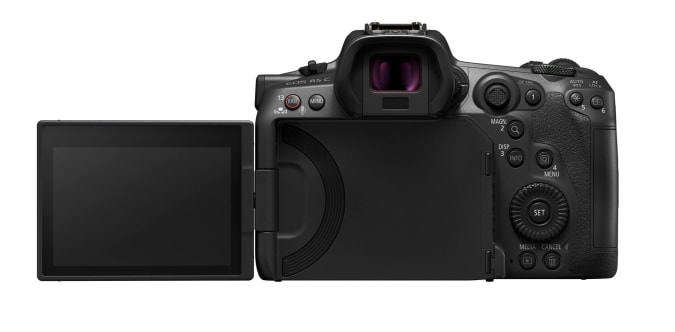Canon has revealed the EOS R5C, a new member of its cinema camera line that looks like a good choice for photos, too. It strongly resembles Canon’s EOS R5 mirrorless camera, but has a big hump in back to accommodate an active cooling system. As such, it offers most of the benefits of the EOS R5 with none of the overheating issues when shooting 8K or high frame rate 4K video.
On the video side, the EOS R5C can shoot 8K at up to 60fps in Canon’s 12-bit RAW LT format using the entire width of the sensor, a big step up from the 8K 30p RAW available on the R5. Better still, it can work at that setting “indefinitely,” while the R5 is limited to just 20 minutes at 8K 30p due to overheating issues. It can also handle RAW 5.9K/60p with a Super 35mm crop, 2.9K/120p with a Super 16 crop, and 4K at up to 120 fps with no crop and full AF capability.
Gallery: Canon EOS R5C cinema camera press images | 20 Photos
Gallery: Canon EOS R5C cinema camera press images | 20 Photos
It also supports ProRes RAW output to an external recorder via the HDMI port at up to 8K/30P. “Proxy data can also be simultaneously recorded to an SD card in-camera, helping to provide efficient post-production operations,” Canon said. Unfortunately, it uses micro HDMI rather than a full-sized port — not ideal for a dedicated cinema camera.
Unlike the R5, however, the R5C doesn’t have in-body stabilization — so any optical shake reduction for stills or video will only be available via supported lenses. However, the optical lens stabilization can work in concert with Canon’s electronic stabilization, with a 1.1x image crop.

Canon
There’s one other notable limitation. Because the EOS R5C uses the same LP-E6NH batteries as the R5, it doesn’t have enough power to operate the lens mount in certain video modes (8K and 5.9K above 30p and 2.9K Super 16 above 60fps). That means you lose autofocus at those settings on battery power only, though you can get it back by using external power from Canon’s PD-E1 USB power supply or its new DC coupler.
On the photography side, the full-frame 45-megapixel sensor is a big plus, as is the 20 fps shooting speed in electronic shutter mode (12 fps with the mechanical shutter). It uses Canon’s Dual Pixel autofocus system for both stills and video, along with eye/face detection and subject tracking, so it should offer the same excellent AF performance as the R5. When you flip the camera over to photo mode, all the menus and button settings change accordingly.
It comes with a 3.2-inch variable-angle flip out LCD monitor and 5.76 million-dot viewfinder, the same as the EOS R5. While you get Canon Log 3 for improved dynamic range, the superior Log 2 option found on other Canon cinema cameras isn’t available. Other features include dual card slots (one CFexpress and one SD UHS-II), animal eye detection (cats, dogs, or birds), vehicles detection, a multifunction shoe for microphones and other accessories, a timecode terminal for multi-cam shoots and a DC coupler to provide continuous power.
The EOS R5C will arrive in March for $4,499, a $600 premium over the R5. It’s a pretty interesting model as it can do more than some Canon cinema camera models for a lot less money and is much smaller, to boot. At the same time, it might give photo/video hybrid shooters serious pause if they’re looking to buy Sony’s $6,500 A1 hybrid.
All products recommended by Engadget are selected by our editorial team, independent of our parent company. Some of our stories include affiliate links. If you buy something through one of these links, we may earn an affiliate commission.
Credit: Source link


Comments are closed.